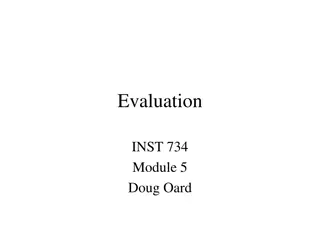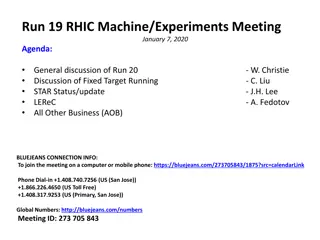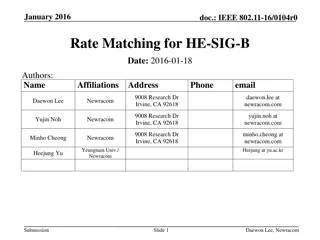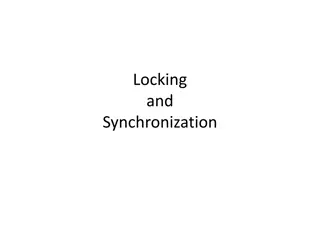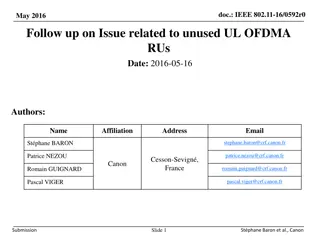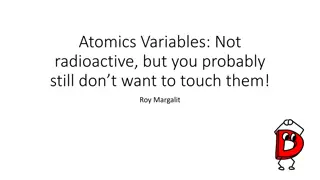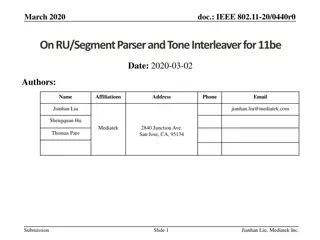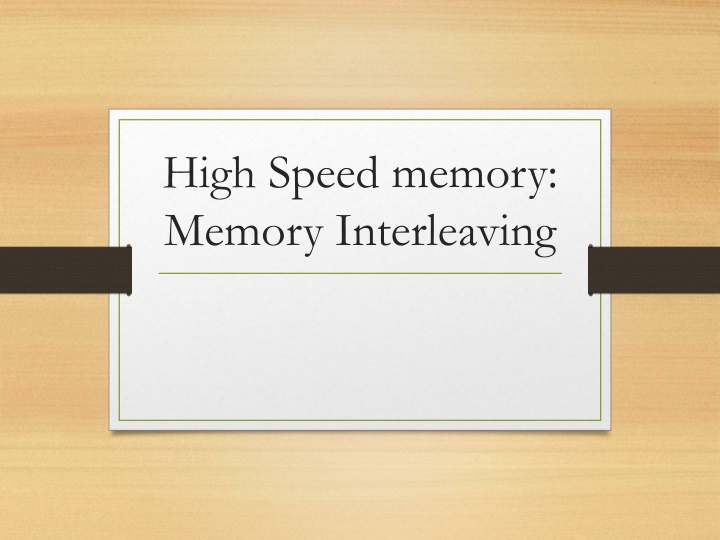
Memory Interleaving and Memory Hierarchy in Computer Systems
Explore the concepts of memory interleaving, main memory hierarchy, DRAMs, SRAMs, memory technology, and memory organization improvements in computer systems. Learn about access times, data transfer speeds, capacity, latency, and more to enhance your knowledge of memory technologies.
Download Presentation

Please find below an Image/Link to download the presentation.
The content on the website is provided AS IS for your information and personal use only. It may not be sold, licensed, or shared on other websites without obtaining consent from the author. If you encounter any issues during the download, it is possible that the publisher has removed the file from their server.
You are allowed to download the files provided on this website for personal or commercial use, subject to the condition that they are used lawfully. All files are the property of their respective owners.
The content on the website is provided AS IS for your information and personal use only. It may not be sold, licensed, or shared on other websites without obtaining consent from the author.
E N D
Presentation Transcript
High Speed memory: Memory Interleaving
Main Memory Bottom of the memory hierarchy Measured in Access Time Time between a read is requested and data delivered Cycle Time Minimum time between requests to memory Time may be required for the memory to recover before the next access Greater than access time to ensure address lines are stable Three Important Issues Capacity Bell s law - 1 MB per MIP needed for balance, avoid page faults Latency Time to access the data Bandwidth Amount of data that can be transferred or affects the time it takes to transfer the block
DRAMS Dynamic RAM Transistor stores each bit Loss over time Must periodically refresh the bits All bits in a row can be refreshed by reading that row Memory controllers periodically refresh, e.g. every 8 ms If the CPU tries to access memory during the refresh, we must wait (hopefully won t occur often) Typical cycle times 60-90ns
SRAMs Static RAM Does not need a refresh Faster than DRAM, generally not multiplexed But more expensive Typical memories DRAM 4-8 times the capacity of SRAM Used for main memory SRAM 8-16 times faster than DRAM Typical cycle times 4-7ns Also 8-16 times as expensive Used to build cache Exceptions; Cray built main memory out of SRAM
Memory Technology SRAM s and DRAM s are different DRAM: 1 transistor/bit; SRAM: 4-6 transistors/bit DRAM capacity is 4-8 times that of SRAM at same feature size SRAM speed is 8-16 times that of DRAM but cost is as much Main memory today means DRAM Multiplexed address lines - row and then column access 2 dimensional address - rows go to a buffer and subsequent column selects sub row Refresh needed every few milliseconds
Memory Example Consider the following scenario 4 cycles to send the address 24 cycles to access a word in the memory unit 4 cycles to transmit the data Hence if main memory is organized by word , then 32 cycles for every word is spent Given a cache block size of 4 words = 32 *4 = 128 cycles is the miss penalty Clearly we need a better organizational model - Memory Organization Improvements
#1 : More Bandwidth to Memory Make a word of main memory look like a cache line Easy to do conceptually Say we want 4 words, so send all four words back on the bus at one time instead of one after the other Problem is the cost of the wider bus between cache and MM Problem Need a wider bus, which is expensive Usually the bus width to memory will match the width of the L2 cache
Interleaved Memory Memory interleaving increases bandwidth by allowing simultaneous access to more than one chunk of memory. This improves performance because the processor can transfer more information to/from memory in the same amount of time and helps alleviate the processor-memory bottleneck that is a major limiting factor in overall performance.
Interleaving works by dividing the system memory into multiple blocks. The most common numbers are two or four, called two-way or four-way interleaving In order to get the best performance from this type of memory system, consecutive memory addresses are spread over the different blocks of memory. It uses all 4 blocks, spreading the memory around so that the interleaving can be exploited.
It is most helpful on high-end systems, especially servers, that have to process a great deal of information quickly. The Intel Orion chipset is one that does support memory interleaving.
Interleaved Memory Banks Take advantage of potential parallelism by interleaving memory Bus bandwidth is the same but we make it work more often 4-way interleaved memory Allow simultaneous access to data in different memory banks then each deliver one word to bus interleaving Good for sequential data
Interleaved memory Interleaved memory is a technique for compensating the relatively low speed of DRAM. The CPU can access alternative sections immediately without waiting for memory to be cached. Multiple memory banks take turns supplying data. An interleaved memory with "n" banks is said to be n- way interleaved. If there are "n" banks, memory location "i" would reside in bank number i mod n.
Main memory is composed of a collection of DRAM memory chips. A number of chips can be grouped together to form a memory bank. It is possible to organize the memory banks in a way is know as interleaved memory. Interleaved memory is one technique for compensating for the relatively slow speed of dynamic RAM (DRAM). Other techniques include page-mode memory and memory caches.
Interleaving Process used to divide the shared memory address space among the memory modules Two types of interleaving 1. High-order 2. Low-order
High-order Interleaving Shared address space is divided into contiguous blocks of equal size. Two high-order bits of an address determine the module in which the location of the address resides. Hence the name High-order Interleaving
Example of 64 Mb shared memory with four modules
High-Order Interleaving (HOI) Address Format n bits bank/module address m bits word in the bank/module (n-m) bits Module 0 Module 1 Module 2 Module 3 0 4 8 12 1 5 9 13 2 6 10 14 3 7 11 15
Example 3 Memory capacity = 64 or 26 no of address bit = 6 Total main module/bank = 4 or 22 2 bits to address module/bank No of bits for word in module/bank = 6 2 = 4 module/bank capacity = 24 = 16 Since these are high order bits, therefore its called HOI 001111 011111 101111 111111 47 15 31 63 M0 M3 M2 M1 010001 000001 100001 110001 0 16 48 010000 000000 100000 110000 32 These bits are same in all 4 modules.
Advantages of HOI Easy memory extension by the addition of one or more memory modules to a maximum of M-1. Provides better reliability, since a failed module affects only a localized area of the address space. This scheme would be used w/o conflict problems in multiprocessors if the modules are partitioned according to disjoint or non- interleaving processes( programs should be disjoint for its success).
Low-order Interleaving Low-order bits of a memory address determine its module
Example of 64 Mb shared memory with four modules
Low-Order Interleaving (LOI) Address Format n bits word in the bank/module (n-m) bits bank/module address m bits Module 0 Module 1 Module 2 Module 3 0 1 2 3 4 5 6 7 8 9 10 11 12 13 14 15
Example 1 Memory capacity = 64 or 26 no of address bit = 6 Total main module/bank = 4 or 22 2 bits to address module/bank No of bits for word in module/bank = 6 2 = 4 module/bank capacity = 24 = 16 Since these are low order bits, therefore its called LOI 62 111100 111101 111110 111111 61 63 60 M3 7 3 M0 4 0 M2 6 2 M1 5 1 000100 000101 000110 000111 000000 000001 000010 000011 These bits are same in all 4 modules.
Low-order Interleaving (cont.) Low-order interleaving originally used to reduce delay in accessing memory CPU could output an address and read request to one memory module Memory module can decode and access its data CPU could output another request to a different memory module Results in pipelining its memory requests. Low-order interleaving not commonly used in modern computers since cache memory
Low-order vs. High-order Interleaving In a low-order interleaving system, consecutive memory locations reside in different memory modules Processor executing a program stored in a contiguous block of memory would need to access different modules simultaneously Simultaneous access possible but difficult to avoid memory conflicts
Low-order vs. High-order Interleaving (cont.) In a high-order interleaving system, memory conflicts are easily avoided Each processor executes a different program Programs stored in separate memory modules Interconnection network is set to connect each processor to its proper memory module
Advantages & Disadvantages (LOI) Advantages It produces memory interference. Disadvantages A failure of any single module would be catastrophic to the whole system.
Associative Memory Associative Memory is also called as Content Addressable Memory because its memory unit is accessed by its content. Associative Memory is mostly used in Application . The disadvantage of this memory is that it is very costly as compared to RAM(Random Access Memory) but its storage area is good.
http://2.bp.blogspot.com/-WOhJSwb_NxM/UM7i9zm7Y6I/AAAAAAAAAYA/LgLIkdk-gII/s400/associativeblockdiagram.jpghttp://2.bp.blogspot.com/-WOhJSwb_NxM/UM7i9zm7Y6I/AAAAAAAAAYA/LgLIkdk-gII/s400/associativeblockdiagram.jpg Block Diagram of Associative Memory:-
Block Diagram consists:- 1)Argument Register. 2)Key Register. 3)Array&Logic of Computer. 4)Match Register.
It comprises of a memory array and logic for m words with n bits per word. Argument register A and key register K both have n bits, one for every bit of a word. Match register M has m bits, one for each memory word. Every word in memory is compared in parallel with content of argument register then the words which match the bits of argument register set a corresponding bit in match register.
To explain with a numerical illustration assume that argument register A and key register K have the bit configuration displayed below. Only three leftmost bits of a compared with memory words since K has 1's on these positions. A K Word 1 Word 2 Word 2 matches unmasked argument field since the three leftmost bits of argument and word are equal. 101 111100 111 000000 100 111100 no match 101 000001 match
An associative memory is more expensive than RAM, as each cell must have storage capability as well as logic circuits for matching its content with an external argument.
Associative memory can be directly accessed by the content rather than the physical address When a word is written in a Associative Memory then no address, name, relative position is given. Associative memory is also capable to find the unused or empty location to store words. In Associative memory each cell has storage capability as well as logic circuit.





